Treatment with the help of the patient’s own information
in the BICOM® mobile VET bioresonance device
In contrast to other “frequency therapy devices”, BICOM® bioresonance is a method that is highly individual and perfectly tailored to the needs of the patient through the use of the patient’s own information and the possibility of testing specific wave patterns for resonance.
The patient’s own pathological and physiological information is recorded using special applicators and fed into the BICOM® mobile VET.
Depending on the therapy program, the specific wave pattern as a carrier of information is amplified, weakened or inverted and transmitted back to the patient in modulated form, which means that the transmission of information changes in clarity depending on the modulation or it disappears completely.
The treatment signals continuously adapt to the changing pathological situation of the patient. As the therapy progresses, the body’s ability to regulate is reactivated.
Find out more about this topic at our regular events. Together with veterinarians and animal naturopaths, we offer various face-to-face and online events .
The BICOM® bioresonance method is a cause-oriented, holistic treatment concept. It can narrow down the cause of the health problem in animals and find out even the hidden causes of the clinical picture.
Animals have a natural regulatory system that can also compensate for unusual influences. However, even good self-healing powers eventually reach their limits. Persistent exposure to allergens, environmental toxins, fungi, viruses, bacteria or stress and changed living conditions weaken the immune system and are often the cause of an illness. In particular, fungal infestation on the skin or chronic diseases in general are not always due to a breeding-related genetic defect, but are signs of a disturbed immune system.
The BICOM® bioresonance method is the key to successful diagnosis and therapy, especially for animals that cannot tell us exactly where it hurts or what the symptoms are. It is a gentle form of therapy that can be carried out without side effects and without additional stress for the animal.
The BICOM® mobile VET records the bioenergetic state of the animal, processes the information it contains and returns modified vibrations / therapy frequency patterns to the animal. Symptoms and stress can be diagnosed and targeted therapy can be initiated.
Through the use of endogenous and exogenous substances, the body’s own self-healing powers can be activated and imbalances that have existed for a long time can also be regulated.
REGUMED Medizintechnik are pioneers of the BICOM® bioresonance method. More than 30,000 therapists worldwide, well over 10,000 of them in Germany, successfully use their therapy concept.
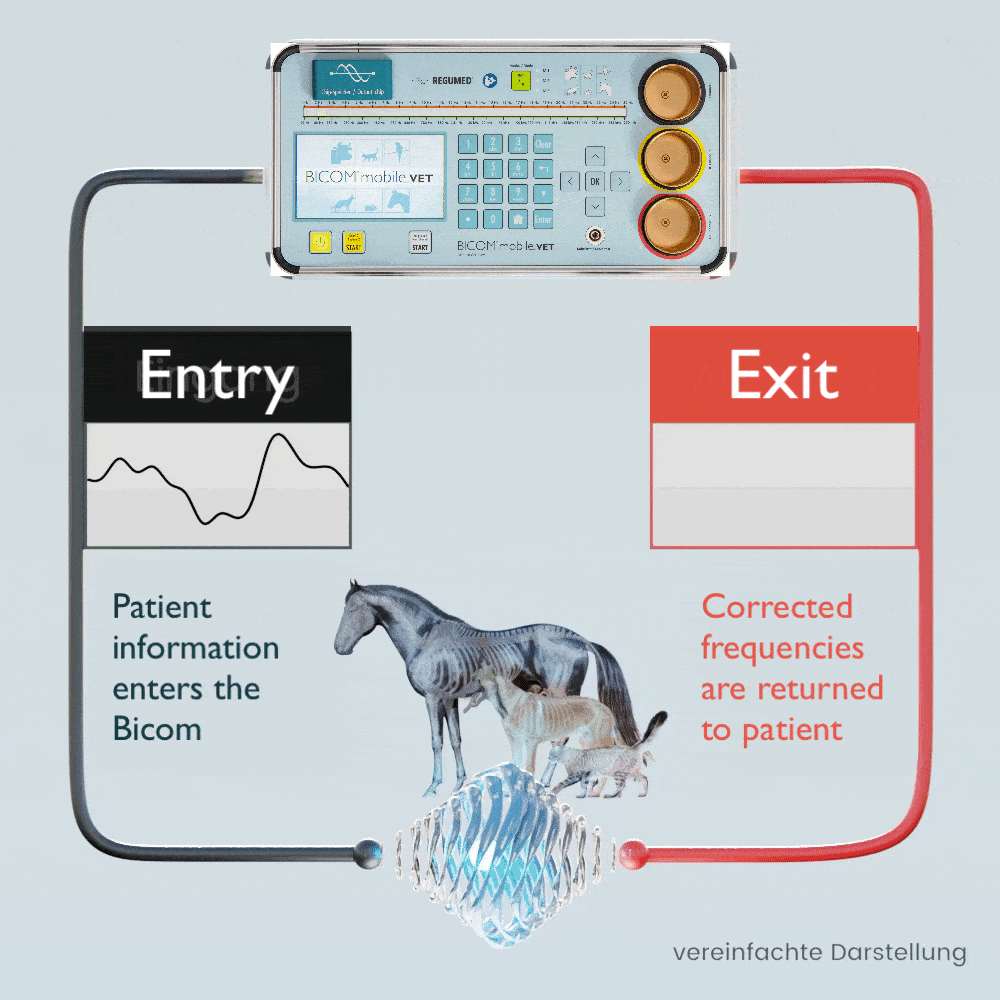
Biophysical basics of the bioresonance method
Life is only possible when three conditions are met: matter, energy and information.
We also find these aspects in conventional medicine, both in diagnostics and in therapy. For example, every drug is also a carrier of information.
Information is neither energy nor matter, it is immaterial and comparable to the meaning of a message from a sending to a receiving system.
In addition to the electrical processes in the receptor proteins and biomembranes in general, electromagnetic interactions through light (biophotons) also play a role in cell communication and the transmission of information.
Specific electromagnetic wave patterns act as information carriers. These wave patterns can be modulated by the BICOM® device in order to eliminate disturbing or stressful information in an organism.
The goal is to restore the free flow of healing information (cell communication) and thus support the self-regulation of the organism and the self-healing powers.
Individual, patient-specific information or information from native substances, digitized substances or information stored on storage media can be used for therapy.
What your colleagues are saying…
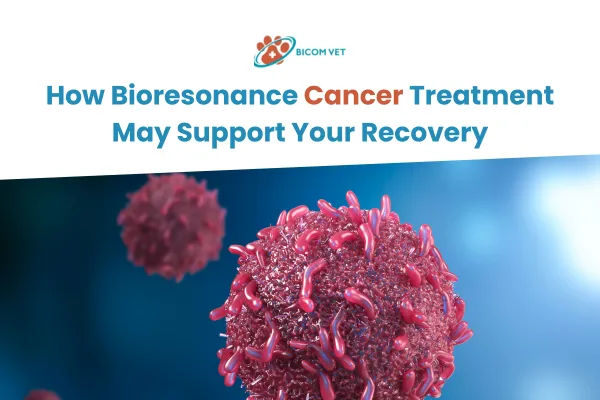
Bioresonance Cancer Treatment Explained
How Bioresonance Cancer Treatment May Support Your Recovery
Bioresonance cancer treatment is a type of complementary therapy that uses electromagnetic frequencies to help detect and correct imbalances in the body. The treatment is based on the theory that every cell emits a unique frequency, and when disease disrupts these frequencies, the body becomes unwell.
Practitioners use bioresonance machines to read the body’s energy patterns and attempt to correct abnormal signals. This therapy is not meant to replace chemotherapy, surgery, or radiation. Instead, it is often used as an additional option to support a patient’s overall well-being during their recovery journey.
More people are turning to bioresonance because of its non-invasive and pain-free nature. While it’s still considered experimental, interest is growing among cancer patients looking for natural and supportive therapies.
Understanding the Process of Bioresonance
The process begins with attaching electrodes to the patient's skin. These sensors send data to the machine, which analyzes energy frequencies emitted by various organs and tissues. If any of the signals fall outside what’s considered normal, the device attempts to correct the imbalance by sending back modified frequencies.
The goal is to reduce stress on the body and help it function more smoothly. Some practitioners believe this can assist in managing symptoms related to cancer or side effects caused by its treatment. These include fatigue, digestive problems, headaches, anxiety, and even sleep disturbances.
Each session typically lasts between 30 to 60 minutes. Most patients find it relaxing, and some report feeling calmer or more balanced afterward.
Is There Scientific Support?
Bioresonance cancer treatment remains a controversial topic in the medical field. Most of the available research is limited to small-scale studies, personal accounts, or laboratory models. This means there's not yet enough solid evidence to confirm how well it works in treating cancer or improving outcomes.
That said, a few early studies suggest it might help reduce discomfort and improve quality of life for some patients. A report published in Complementary Therapies in Clinical Practice mentioned that bioresonance may help with symptoms like nausea, tiredness, and mental fog during cancer care.
Other studies have looked at how bioresonance might affect the immune system or stress response. However, more comprehensive trials are needed before any definite claims can be made. For now, it remains a therapy that should only be used as a secondary option—not a substitute for medically approved treatments.
Common Reasons Patients Consider This Therapy
Cancer affects not only the body but also the emotional and mental well-being of the person going through it. For many, traditional treatments such as radiation and chemotherapy can be physically draining. These treatments also carry side effects like hair loss, weakened immunity, nausea, and pain.
This is where therapies like bioresonance come into consideration. It offers a way to feel more involved in one’s healing and adds another layer of care that is focused on the whole person, not just the disease.
Patients who try bioresonance often say they feel more energized, less anxious, and more hopeful. Even if the therapy does not directly target the cancer itself, the emotional comfort and sense of control can be incredibly valuable.
What You Should Know Before Starting
If you're considering bioresonance cancer treatment, it's important to manage expectations and make informed choices. Here are some key things to keep in mind:
Always speak with your oncologist or healthcare provider first. Your safety and treatment schedule should come first.
Use it only as a complementary therapy. Never delay or skip approved treatments in favor of bioresonance.
Look for a trained and experienced practitioner. Ask questions about their background, the equipment they use, and how many cancer patients they've worked with.
Check the type of machine being used. Some devices are approved for use in wellness clinics, while others are not regulated or tested for safety.
Knowing this will help you stay safe while exploring possible supportive care options.
Reported Experiences from Real Patients
The most common feedback from patients is that they feel calmer, more balanced, and more in control of their health. Some say they sleep better or have fewer digestive problems. Others mention that they feel lighter emotionally, especially when used alongside psychological support or counseling.
One cancer survivor reported feeling drained and mentally foggy after chemotherapy but noticed a clear improvement in energy and mood after weekly bioresonance sessions. Another said that while their tumor required medical intervention, they credited bioresonance with helping them manage side effects and maintain a sense of peace.
Of course, these are personal experiences and should not be considered scientific proof. But they do point to the potential of bioresonance as a tool for comfort and improved well-being during difficult times.
Limitations and Concerns
There are important limits to what bioresonance cancer treatment can do. It does not shrink tumors, destroy cancer cells, or reverse the disease. It should never be used as a replacement for chemotherapy, immunotherapy, or surgery.
Some risks lie not in the treatment itself but in how it’s used. Delaying medical treatment in favor of alternative options can reduce chances of survival and make the disease harder to manage. Another concern is cost, as these sessions can add up quickly and are not usually covered by insurance.
Make sure you’re using this therapy wisely—with a clear understanding of what it can and cannot do.
Financial Considerations
Because this treatment is considered alternative, most insurance providers do not cover it. That means patients usually pay out of pocket. A single session can cost between $50 and $150 depending on the provider, location, and length of treatment.
Some clinics offer packages, and a few holistic centers may offer reduced rates for patients with serious conditions. It’s important to ask upfront about pricing, expected number of sessions, and whether discounts are available for longer-term plans.
Consider your budget and your other medical expenses before committing to multiple sessions.
Integrating Bioresonance into Your Healing Plan
If you and your doctor agree that trying bioresonance could be a helpful addition to your care, the next step is to create a safe and realistic plan. This might include:
Booking sessions at a clinic experienced in supporting cancer patients.
Keeping a symptom journal to track changes in energy, mood, or side effects.
Combining therapy with stress-reducing habits like meditation, proper nutrition, and gentle movement such as yoga or walking.
Staying consistent with your scheduled hospital treatments and appointments.
When used carefully and thoughtfully, bioresonance may serve as a helpful tool to support the body’s overall wellness during recovery.
How It May Help With Emotional Well-being
Facing cancer can take a major emotional toll, often leading to stress, fear, and anxiety. Some patients say this therapy helps them feel calmer and more emotionally grounded. The relaxing environment and focus on balance may provide a sense of peace during an overwhelming time.
While emotional relief isn’t a cure, it plays an important role in recovery. Feeling emotionally supported can make it easier to stick with other treatments and cope with daily challenges.
The Importance of Setting Realistic Expectations
It’s essential to approach this therapy with the right mindset. It won’t shrink tumors or eliminate cancer cells, but it may offer comfort and symptom relief. Viewing it as one piece of a broader recovery plan helps avoid disappointment and supports better decisions.
Clear communication with both your oncologist and therapist can ensure the treatment fits safely into your overall care. Always prioritize evidence-based medical advice when making choices.
FAQs
1. What is the main goal of this therapy?
The aim is to support the body's balance by correcting abnormal energy frequencies. It may help reduce stress and discomfort during recovery.
2. Can it replace chemotherapy or other medical treatments?
No, this method should never replace approved medical treatments. It is only meant to be a complementary option.
3. Are there any side effects from this therapy?
Most users report no major side effects. Sessions are generally painless and considered safe when done correctly.
4. How often should sessions be scheduled?
Frequency varies, but many patients attend weekly or biweekly. The exact plan depends on individual needs and practitioner advice.
5. Is this therapy covered by insurance?
In most cases, it’s not covered by insurance providers. Patients usually pay out of pocket for each session.
Conclusion
Bioresonance cancer treatment is drawing attention for its gentle and non-invasive nature. While the scientific evidence is still limited, many patients appreciate the relief and emotional support it may offer.
This approach is not a cure and should never replace conventional treatments. However, when used responsibly and alongside approved cancer care, it may bring comfort, ease, and a sense of support during a difficult period in life.
If you are interested in this therapy, speak to your healthcare team, find a trusted provider, and approach the treatment with an open but informed mind.
Treatment Priorities
For gentle and optimal treatment of the causes of diseases in animals
The BICOM® bioresonance method is predestined for use with large and farm animals such as horses , but also with dogs , cats and small animals. The treatment focus of the BICOM® mobile VET is wide-ranging. It is now used for many indications.
It recognises health deficits at an early stage and is used, among other things, for the following symptoms:
sweet itch
Feed intolerances
allergies and related diseases
COB/COPD
leishmaniasis
Lyme disease
anaplasmosis
lameness in horses
hoof ulcer
Poisoning by poisoned baits, plants etc.
mauke
Feline infectious peritonitis (FIP)
Cat flu/cat disease
eye/conjunctivitis
and much more
Get advice now!
Our experts are happy to be there for you personally
Our BICOM® bioresonance experts are available to answer any questions you may have
and will be happy to advise you personally and individually.
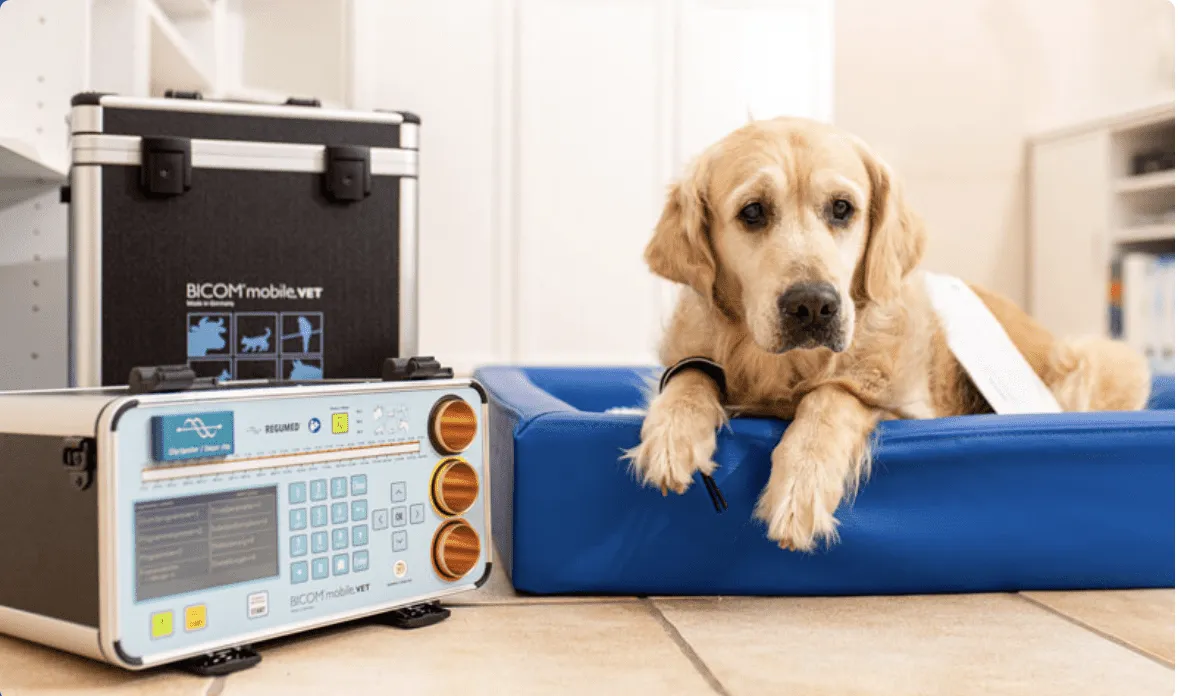



Request more information
Quick Links
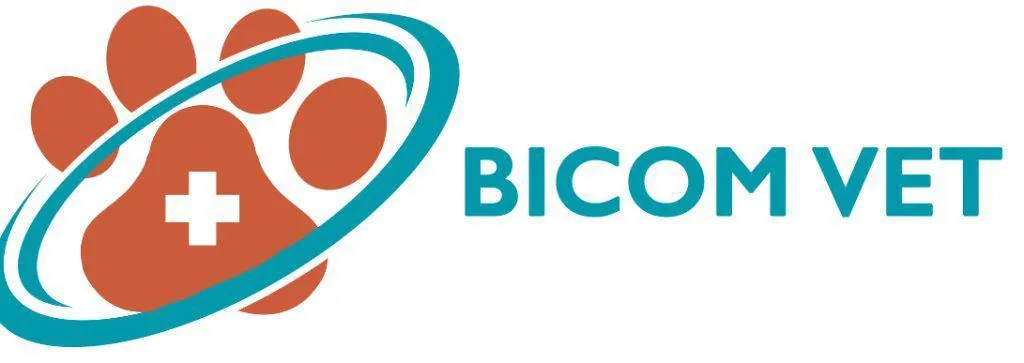
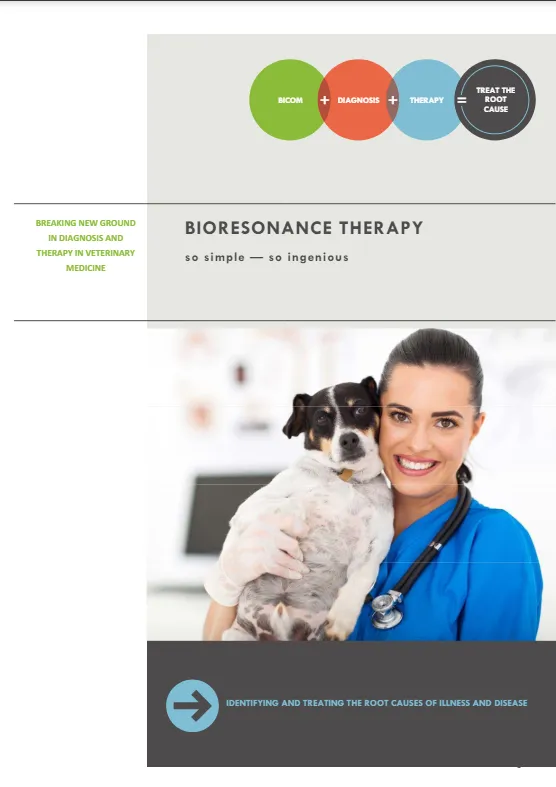
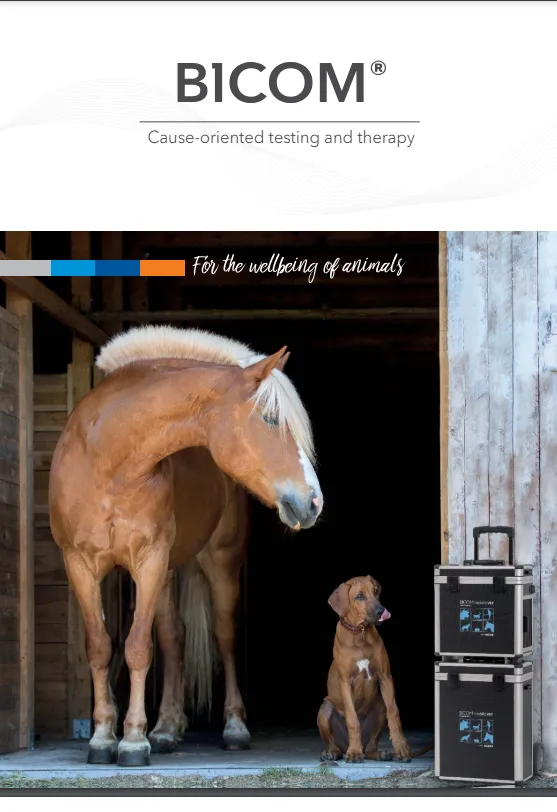

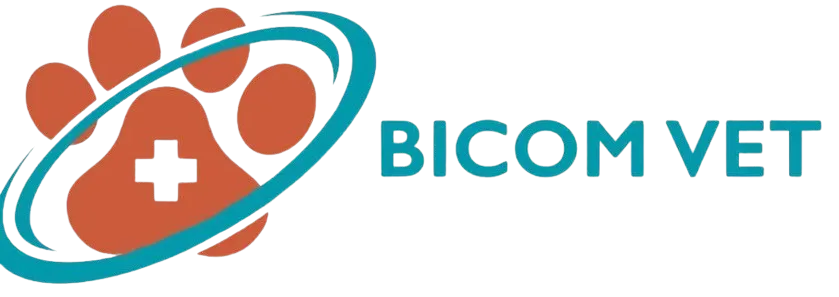
Facebook
Instagram
Mail